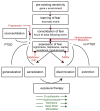An Overview of Translationally Informed Treatments for Posttraumatic Stress Disorder: Animal Models of Pavlovian Fear Conditioning to Human Clinical Trials
- PMID: 26238379
- PMCID: PMC4527085
- DOI: 10.1016/j.biopsych.2015.06.008
An Overview of Translationally Informed Treatments for Posttraumatic Stress Disorder: Animal Models of Pavlovian Fear Conditioning to Human Clinical Trials
Abstract
Posttraumatic stress disorder manifests after exposure to a traumatic event and is characterized by avoidance/numbing, intrusive symptoms and flashbacks, mood and cognitive disruptions, and hyperarousal/reactivity symptoms. These symptoms reflect dysregulation of the fear system likely caused by poor fear inhibition/extinction, increased generalization, and/or enhanced consolidation or acquisition of fear. These phenotypes can be modeled in animal subjects using Pavlovian fear conditioning, allowing investigation of the underlying neurobiology of normative and pathological fear. Preclinical studies reveal a number of neurotransmitter systems and circuits critical for aversive learning and memory that have informed the development of therapies used in human clinical trials. In this review, we discuss the evidence for a number of established and emerging pharmacotherapies and device-based treatments for posttraumatic stress disorder that have been developed via a bench to bedside translational model.
Keywords: Antidepressant; Cannabinoid; D-Cycloserine; Exposure; Extinction; Fear; Glucocorticoid; Hydrocortisone; Morphine; Opioid; Propranolol.
Copyright © 2015 Society of Biological Psychiatry. Published by Elsevier Inc. All rights reserved.
Figures

References
-
- American Psychiatric Association., American Psychiatric Association. DSM-5 Task Force. Diagnostic and statistical manual of mental disorders : DSM-5. 5. Washington, D.C: American Psychiatric Association; 2013.
-
- Kessler RC, Sonnega A, Bromet E, Hughes M, Nelson CB. Posttraumatic stress disorder in the National Comorbidity Survey. Archives of general psychiatry. 1995;52:1048–1060. - PubMed
-
- Yehuda R. Risk and resilience in posttraumatic stress disorder. The Journal of clinical psychiatry. 2004;65(Suppl 1):29–36. - PubMed
-
- Davis M. The role of the amygdala in fear and anxiety. Annual review of neuroscience. 1992;15:353–375. - PubMed
-
- LeDoux J. The amygdala. Current biology : CB. 2007;17:R868–874. - PubMed
Publication types
MeSH terms
Grants and funding
LinkOut - more resources
Full Text Sources
Other Literature Sources
Medical

